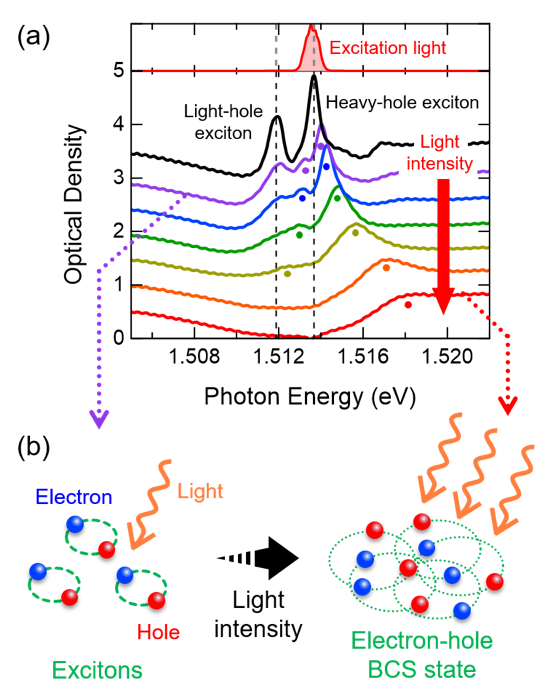An innovative method successfully realized light-driven electron-hole pair state similar to superconductivity in a semiconductor
For the first time in the world, the collaborative research group demonstrated a new quantum state (an electron-hole BCS state), in which electrons and holes are paired, could be generated by irradiating a semiconductor with laser light. This has been predicted in theory for several decades but never demonstrated under experimental conditions. This time, the group took an unprecedented and unique approach and succeeded by utilizing the strong interaction between laser light and excitons (the electronic state in semiconductor).
(a) Transient optical absorption spectrum of semiconductor crystal (GaAs) under laser light irradiation (lower part of Fig. (a)). The wavelength of the excitation light (the upper part of the figure (a) is matched to the exciton energy (“heavy hole exciton” in the figure). As the excitation light intensity increases, the exciton absorption peak splits into two (i.e. the colored dots in the figure) and changes to a cliff-like structure. This shows the transition from the exciton state to the electron-hole BCS state. (b) Conceptual diagram of the transition from the exciton ensemble to an electron-hole BCS state. As the light intensity increases, the density of electron-hole pair increases and changes from an exciton state to an electron-hole cooper pair state.
They controlled the wavelength of the laser beam and generated a new quantum state (i.e. an electron-hole BCS state) by directly aiming at excitons in gallium arsenide semiconductor cooled to 5 K. The group employed an unprecedented method of increasing the optical density of excitons. The realization of a new quantum state (i.e., an electron-hole BCS state) using this technique advances the understanding of the electronic state that occurs when a semiconductor is irradiated with light, and also provides deeper understanding of the new type of quantum condensation phenomena in variety of materials going forward.
The success is a result of the collaborative effort of a research group led by Professor Ryo Shimano and PhD candidate Yuta Murotani at the Cryogenic Research Center and the Department of Physics in the Graduate School of Science, The University of Tokyo, Professor Hidefumi Akiyama of the Institute for Solid State Physics of the University of Tokyo, and a group from Princeton University (U.S.A.)
Reference
- Journal:Physical Review Letters
- Title:Light-driven electron-hole Bardeen-Cooper-Schrieffer-like state in bulk GaAs
- Authors:Yuta Murotani, Changsu Kim, Hidefumi Akiyama, Loren N. Pfeiffer, Ken W. West, and Ryo Shimano
- DOI:https://doi.org/10.1103/PhysRevLett.123.197401

